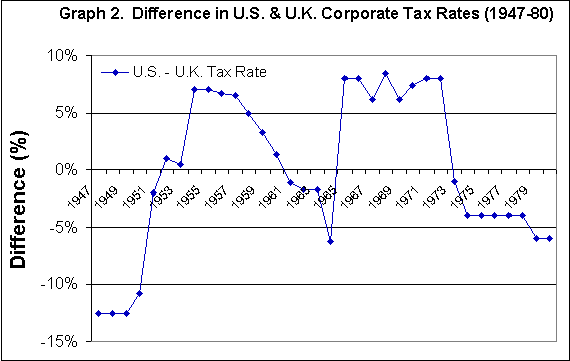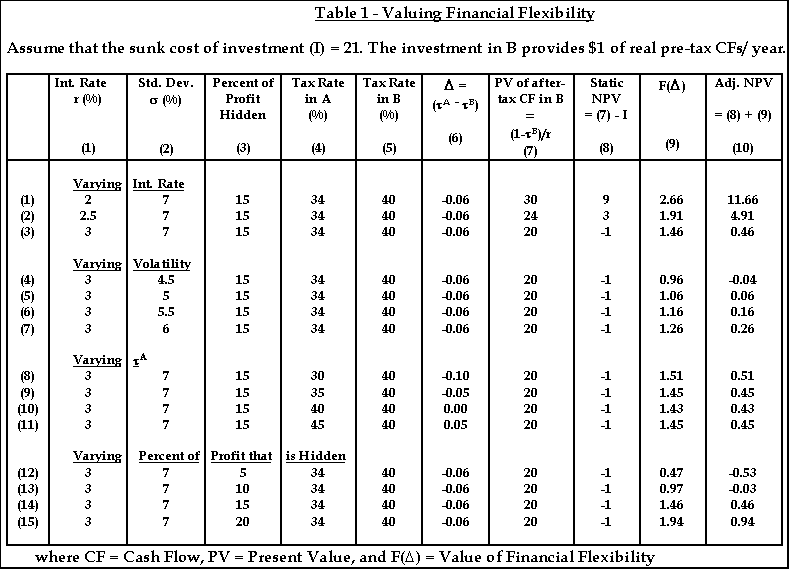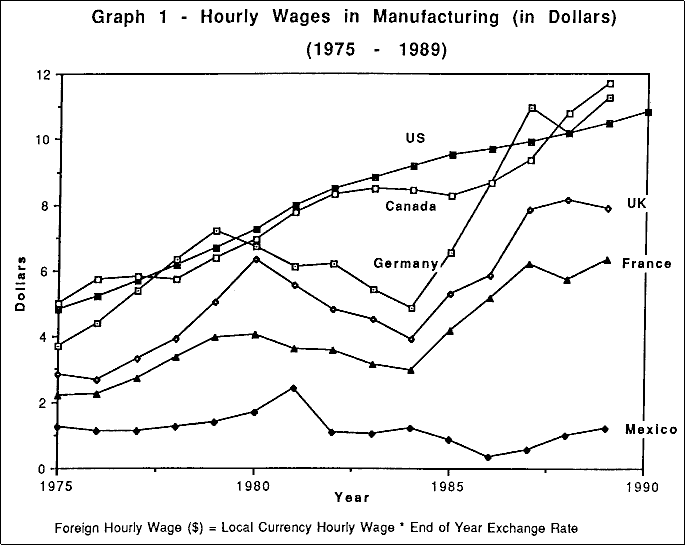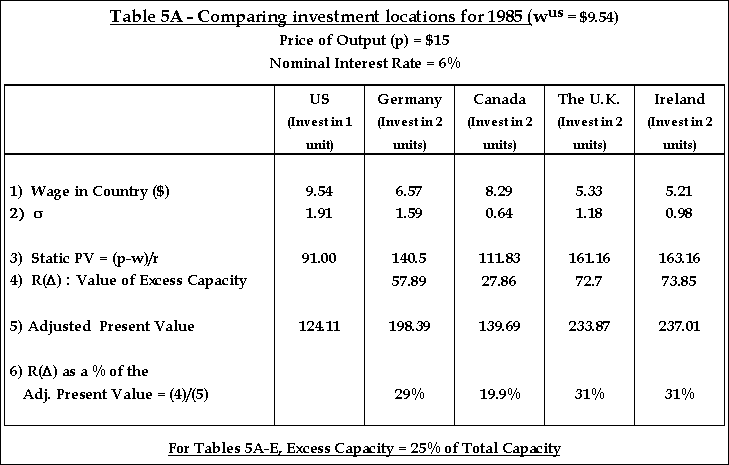 Comments?
You can send e-mail to Dr. Arun Muralidhari:
arunmura@hotmail.com
Comments?
You can send e-mail to Dr. Arun Muralidhari:
arunmura@hotmail.com
Volatility, Flexibility and the Multinational Enterprise is the title of the Ph.D. dissertation, submitted in May 1992 to the Sloan School of Management, MIT, by Arun Muralidhar.
Dr. Arun Muralidhar is currently Vice President of J.P. Morgan Investment Management Inc.
He shares with our readers the abstract of his dissertation and two chapters from his thesis
(full text to download). In these chapters, Dr. Muralidhar applies
real options approach to evaluate the multinational flexibility value.
He describes uncertainties across the countries, such us the corporate tax level, exchange rates,
production factors like wages, etc., and showing how this affect the option value of a multinational
firm.
 Comments?
You can send e-mail to Dr. Arun Muralidhari:
arunmura@hotmail.com
Comments?
You can send e-mail to Dr. Arun Muralidhari:
arunmura@hotmail.com
![]()
As submitted to the Sloan School of Management (May 1992) in partial fulfillment of the requirements for the Degree of Doctor of Philosophy
Many arguments have been put forth to justify the existence of a multinational enterprise (MNE) that emphasize its ability to diversify business risks. Some of these arguments have been discredited because investors can diversifying these risks as well as, if not better than MNEs. However, certain risks that arise from volatility in demand for products, factor costs and tax regimes can give rise to major advantages for the MNE that can internalize real and/or financial flexibility, because firm-level diversification cannot be replicated by investors. When faced with adverse cost shocks, management of the MNE exercises the real and financial options that flexibility provides. By exercising these options, management maximizes the expected future cash flow stream, thereby enhancing the value of the MNE's investment portfolio.
We first show in a partial equilibrium setting that tax regime volatility provides a competitive advantage to the multinational vis-a-vis a uninational firm or investor-level diversification, because the market for tax shields is incomplete. We then show how multinational firms should value flexibility when tax regimes, factor costs and exchange rates are volatile, and how a valuation of real and financial flexibility impacts strategic decision-making by MNEs.
The first paper demonstrates that the mere existence of asymmetric and changing tax regimes around the world provides a sufficient condition for a uninational firm to invest abroad (i.e., provide an additional reason for the existence of a MNE), possibly even in a relatively high tax jurisdiction. We prove that by internalizing tax management and thereby creating the ability to shift some fraction of profits from a high tax to a low tax jurisdiction, a multinational is afforded the opportunity to increase expected firm value above that of an exact set of purely national firms.
The next two papers demonstrate that having operations in more than one country provide MNEs with flexibility, and how static NPV analyses may not capture the value of this flexibility. We argue that the value of a foreign project = NPV of the foreign project assuming that it was a stand-alone project + value of financial and real flexibility that the project provides the parent organization, where we define financial flexibility to be the ability to shift profits to favorable tax locations when tax regimes are changing and real flexibility to be the ability to switch capacity utilization to the lowest cost location when domestic costs and exchange rates are volatile.
We introduce options pricing models to value flexibility and offer an adjusted NPV calculation that incorporates this portfolio of options into the investment decision. In each case, the models are also used to compare competing investment locations using "stylized" tax and wage (and exchange rate) data from some countries and to comment on optimal investment location and capacity choice decisions. While the values generated in our simulations are a first approximation of the true value of flexibility, they provide a benchmark for the potential value of the real and financial flexibility of MNEs. We also attempt to provide a valuation methodology to capture the "true value" of incremental FDI within a MNE environment.
The key result of these papers is that MNEs with flexibility should be more concerned with the degree of correlation of business environments (tax regimes and factor costs) across countries than the country-level variance of these same business costs considered in isolation.
 Thesis Committee :
Thesis Committee :![]()
 Download the Chapter 2 of his thesis: compressed
files in zip format with 82 Kb;
Download the Chapter 2 of his thesis: compressed
files in zip format with 82 Kb;
or the self-extracting compressed files (.exe) with 111 Kb.
Attention: after decompression you get 6 files.
 Abstract
Abstract
This paper argues that when corporate tax obligations are variable, a multinational firm has financial
flexibility (the option to shift profits to favorable tax regions in every period and lower the global tax
liability), and that traditional NPV analyses of foreign projects may not capture the value of this flexibility.
It introduces an options pricing model to value the flexibility that internalizing tax management provides,
and offer an adjusted NPV calculation that incorporates this portfolio of options into the investment
decision. While national firms may find certain projects unattractive, a multinational firm is shown to
acquire projects once they value the flexibility. Corporate tax rate data is used to compare potential
projects in different countries for a US-based MNE.
The paper concludes by discussing the implications of these results for MNEs and governments.
 Some Highlights from Chapter 2
Some Highlights from Chapter 2
This paper presents the financial flexibility value of a multinational firm, to shift part of the profits to a more favorable regions. This option value can transform some unattractive projects for national firms, into acceptable projects for a multinational firm.
The source of uncertainty in this case are the fluctuation of the corporate tax rates between the
countries. Although this variability in tax regimes has been studied before, very little attention has been
given to the effect of the co-variation of tax regimes across the countries, in the
investment decisions for multinationals.
The figure below presents the difference between the corporate tax rates in US and UK, from 1947 to 1980.

The difference, US Tax Rate - UK Tax Rate, presented above is modeled as a stochastic process (Brownian motion without drift). With this source of uncertainty and with financial flexibility is possible to answer some questions with options pricing theory.
There is an asymmetry of information between multinational firms and tax authorities, because
is harder for the latter to know all the international connections of the costs (transfer-prices) and
production (intra-company goods flows), that is, the geographical distribution of profits.
Outsiders like government agencies, can only observe global pre-tax profits,
and are unable to distinguish the exact contribution from each plant in different countries.
A more robust supposition, is that of the $1 generated by each plant, a multinational has to
declare locally only a fraction (1 - g) of $1, and the remaining fraction
g has the option to be shifted to a more favorable country through
creative transfer-price strategy or similar.
The parameter g is
called the percent of profit that is hidden and has optional allocation.
Suppose the following case. A multinational can invest in two units, one in the country A and other in
the country B. The investment in B can be profitable for a multinational due the value of the flexibility and
not for a national firm, without this financial flexibility.
In the base case, g = 15%.
The following table shows the value of flexibility F (column 9) for several cases, varying interest
rate, volatility, corporate tax of A, and the percent of profit that is hidden.

Note in the table above that:
![]()
 Download the Chapter 3 of his thesis:
compressed files in zip format with 110 Kb;
Download the Chapter 3 of his thesis:
compressed files in zip format with 110 Kb;
or the self-extracting compressed files (.exe) with 140 Kb.
Attention: after decompression you get 8 files.
 Abstract
AbstractA multinational firm has the option to switch production to the lowest cost location when either factor prices or exchange rates change, and this paper argues that NPV analyses may not capture the value of this operational flexibility. An options pricing model is introduced to value flexibility and an adjusted NPV calculation is offered that incorporates the value of these real options. Once the investment rule is revised, the costs of acquiring operational flexibility are compared to the value that a foreign investment adds to existing investments. The paper shows that in some cases valuable projects may be rejected if the value of flexibility is not included. The model is also used to compare competing investment locations and to comment on optimal location, capacity choice (and investment timing) decisions. The paper is tested with wage data for a host of countries and concludes by discussing the implications of such an approach for U.S.-based MNEs.
 Some Highlights from Chapter 3
Some Highlights from Chapter 3
In addition to the financial flexibility advantage, multinationals have operational flexibilities that
are not accessible for national firms.
Dr. Muralidhar wrote: "multiple sourcing relationships allow MNEs [multinational enterprises]
to mitigate losses that stem from unanticipated changes in input costs in a particular country or from
adverse exchange rate movements."
One input cost with variability is the wage, still more when this cost is multiplied by an
exchange rate that is also stochastic.
The chart below shows the hourly wages in manufacturing for several countries. Both, the
wage itself of each country and the difference of wages between two countries, change with the time.

More important for a multinational is the co-variability of input costs of production in plants from
different geographical regions than the input cost variability considered in isolation. So, this chapter
models the difference of two input costs (two countries) following a stochastic process
(Brownian motion without drift).
Due the input cost uncertainty, multinationals with excess capacity in the foreign locations,
actively shift capacity utilization when wages or exchange rates change unfavorably, in order to prevent
losses or profit margins reductions.
In this model, is assumed a costless switch of production. The real option case is: in every period,
management will observe the unit costs and the exchange rates in the two countries and decide whether
or not to exercise the option to shift capacity utilization abroad.
Dr. Muralidhar again shows how an exclusion of the value of the option (operational flexibility in
this case) can lead to an incorrect rejection of a foreign project.
The following table presents one case analyzed. One plant (or unit) is built in US and there are several countries to invest in another plant. In addition to the static PV of cash flows (row 3), there is an option value due the excess capacity (row 4). The table shows that flexibility can reach a very significant value (20 to 30% of the total adjusted present value, see row 6).

In these calculations, was considered an excess capacity of 25% (is not realistic to think that all
the production can be shifted).
Note that Canada presents a lower flexibility value than other countries. This problem takes the US
point of view. Canada and United States have higher correlation between the input costs than US and
any other analyzed country. So, a plant in Canada has less flexibility value (to shift production) than an
European country, by the point of view of an American firm.
 The additional comments by Dr. Arun Muralidhar completes this summary about
his dissertation papers focusing investment decisions of MNEs [multinational enterprises]:
The additional comments by Dr. Arun Muralidhar completes this summary about
his dissertation papers focusing investment decisions of MNEs [multinational enterprises]:
"The one interesting result from this work which I am not sure you have captured is the counter-intuitive result that a MNE may invest in high tax and high wage locations if the value of the option is sufficient to overcome this disadvantage. The reason this is important is that you often hear that companies have located factories in developed markets (high cost locations) and this is a good way to explain these decisions.
The second result which was in the Appendix is that unlike the Pindyck model, not only is investment timing affected by the variability, but also investment location and choice of capacity. One issue I had with the Pindyck model, which is a purely domestic model, was the absence of excess capacity for companies, whereas we know globally that there is excess capacity. Therefore, the correct evaluation of capacity must be made from a global rather than local perspective."
![]()
![]()